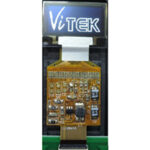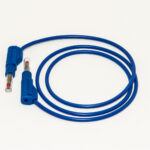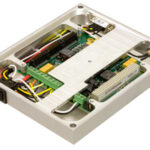Description
The HM-10 is a small 3.3v SMD Bluetooth 4.0 BLE module based on the TI CC2540 or CC2541 Bluetooth SOC (System On Chip). The HM-10 is made by Jinan Huamao and is one of many Bluetooth devices they produce including the HM-11 which is operationally the same as the HM-10 but has a smaller footprint with fewer pins broken out.
There are 2 versions of the HM-10; the HM-10C and the HM-10S
The HM-10C does not have the pads along the bottom (the usb connections) and has 26 pads instead of 34 which makes it a little cheaper to produce. There may be other differences (such as the type of crystal used) due to the date of manufacture. Operationally the two are the same though.
HM-10 Basic specs
+2.5v to +3.3v
Requires up to 50mA
Uses around 9mA when in an active state
Use 50-200uA when asleep
RF power: -23dbm, -6dbm, 0dbm, 6dbm
Bluetooth version 4.0 BLE
Default baud rate for the serial connection is 9600
Default PIN is 000000
Default name is HMSoft
Based on the CC2540 or the CC2541 chip
The latest HM-10s all appear to the the CC2541 chip. This is the same as the CC2540 except it is lower power and has a shorter range. The CC254x is based on the 8051 and runs at 32MHz.
The HM-10 is has become a very popular Bluetooth 4 BLE module for use with the Arduino. In part due to the standard UART serial connection that makes it fairly straight forward to connect to an Arduino. The UART layer is a good thing and a bad thing, it allows ease of use but it hides the BLE layer so you have no control over the actual BLE side of things. The HM-10 is Bluetooth version 4.0 only. This means it cannot connect to Bluetooth 2/2.1 modules such as the HC-06 and HC-05.
The HM-10 is controlled via AT commands which are sent over the serial UART connection. There are a host of commands, some simple, some more complex, and these are covered later.
HM-10 on a breakout board
The HM-10 is also available mounted to a breakout board that exposes the power and UART connections to breadboard friendly male pins. The breakout board includes a 3.3v power regulator that makes them 5V compatible. This makes them ideal for hobbyists like me. You should note that the RX pin is is still 3.3v and when using a 5v Arduino you should covert the Arduinos 5v TX to 3.3v for the HM-10 RX.
Manufacturer Part Number: HM-10S
Manufacturer: Electronic Components





